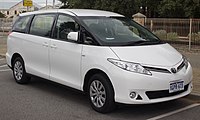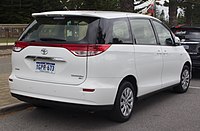Motor vehicle
| Toyota Previa | |
|---|---|
 | |
| Overview | |
| Manufacturer | Toyota |
| Also called |
|
| Production | January 1990 – October 2019 |
| Body and chassis | |
| Class | Minivan |
| Body style | 4/5-door minivan |
| Layout |
|
| Chronology | |
| Predecessor | Toyota TownAce/MasterAce Surf (R20/R30) |
| Successor |
|
The Toyota Previa, also known as the Toyota Estima (Japanese: トヨタ・エスティマ, Hepburn: Toyota Esutima) in Japan, and Toyota Tarago in Australia, is a minivan that was produced by Toyota from 1990 until October 2019 across three generations.
The name "Previa" is derived from the Spanish for "preview", as Toyota saw the first Previa as a vehicle that would preview technologies used in future minivans. The Previa was the second largest minivan in Toyota's lineup in Japan after the bigger and more luxurious Alphard/Vellfire.
First generation (XR10/XR20; 1990)
Motor vehicle| First generation (XR10, XR20) | |
|---|---|
 1996–2000 Toyota Tarago GLi (TCR10R, Australia) 1996–2000 Toyota Tarago GLi (TCR10R, Australia) | |
| Overview | |
| Also called |
|
| Production | January 1990 – December 1999 |
| Model years | 1991–1997 (North America) |
| Assembly |
|
| Designer | Tokuo Fukuichi; David Doyle (1987) |
| Body and chassis | |
| Layout | |
| Powertrain | |
| Engine | |
| Transmission |
|
| Dimensions | |
| Wheelbase | 112.8 in (2,865 mm) |
| Length |
|
| Width | 1,800 mm (70.9 in) |
| Height |
|
| Curb weight | 1,703 kg (3,755 lb) |
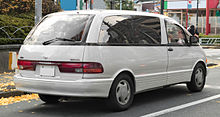 1990–1994 Toyota Estima (Japan)
1990–1994 Toyota Estima (Japan) 1998–1999 Toyota Estima V Limited (TCR10W; facelift, Japan)
1998–1999 Toyota Estima V Limited (TCR10W; facelift, Japan)
The first generation, designed by Toyota designer Tokuo Fukuichi and Calty designer David Doyle in 1987 (patent filed 24 December 1987), was introduced on 27 January 1990, and had only one sliding side door for the rear passengers. It featured a mid-engined platform, where the inline-four cylinder gasoline-powered engine was installed almost flat (at a 75-degree angle), beneath the front seats.
Installing the engine in this configuration allowed moderately easy access to the spark plugs, which were located underneath a panel on the mid right-side of the vehicle, after removing the front right seat, the carpet and an access panel.
All of the engine-driven accessories, such as the alternator, power steering pump, air conditioning compressor and radiator fan, are accessible from the front hood and are driven by an accessory driveshaft on the front of the engine. This method received the name Supplemental Accessory Drive System, or "SADS". Placing these items in front allowed the designers to achieve an even front/rear weight distribution, which benefits ride quality and handling. However, it also prevented the installation of a larger engine, and meant that the design and development costs could not be mitigated by sharing the platform with other vehicles.
The first generation Previa was 4,750 mm (187.0 in) long and 1,800 mm (70.9 in) wide. In Japan, two smaller versions, the Toyota Estima Lucida and Toyota Estima Emina, were produced from January 1992, which were approximately 110 mm (4.3 in) narrower and 70 mm (2.8 in) shorter than the standard model. The original design continued to be sold in Japan, but became known as the "wide-body" Estima.
The reason that the smaller Emina and Lucida models were developed is the vehicle tax system in Japan, which is based on the product of the length and width of the car; the smaller variants fall into a lower tax band. The Estima Emina and Estima Lucida were also available with a 2.2-liter diesel engine (3C-T and 3C-TE). In Japan, the Estima and Estima Emina were exclusive to the dealerships called Toyota Store. The Estima Lucida sold at Toyota Corolla Store dealerships. The two received small redesigns in 1994 and a facelift in 1996.
The first generation Previa was available in both rear- and all-wheel drive versions (called All-Trac) and powered by a 135 PS (99 kW) JIS four-cylinder 2.4-liter fuel injection engine. Available with a four-speed automatic or five-speed manual gearbox, this Previa also seated seven or eight people, with three seating configurations offered (North America only received the seven passenger configurations, however).
All configurations have a driver and front passenger seat forward, and a three-seat bench seat at the rear that splits and folds flat against the sides of the cabin. The eight-seat configuration contains a 2/1 split swiveling bench seat in the middle row, while the seven-seat configurations contain either two independently swiveling captain's chairs (referred to as "Quad Seating"), in the middle row or a two-seat bench offset towards the driver's side. The third row is better upholstered in the seven-seat version.
The Previa was available with either four-wheel disc brakes or traditional front disc/rear drum brake setup, with anti-lock brakes (ABS) as an option.
- Estima Emina
-
1992–1994 Toyota Estima Emina (Japan)
-
1992–1994 Toyota Estima Emina (Japan)
-
 1994–1996 Toyota Estima Emina (Japan)
1994–1996 Toyota Estima Emina (Japan)
-
 1996–1999 Toyota Estima Emina (Japan)
1996–1999 Toyota Estima Emina (Japan)
- Estima Lucida
-
 1992–1994 Toyota Estima Lucida (Japan)
1992–1994 Toyota Estima Lucida (Japan)
-
 1992–1994 Toyota Estima Lucida (Japan)
1992–1994 Toyota Estima Lucida (Japan)
-
 1994–1996 Toyota Estima Lucida (Japan)
1994–1996 Toyota Estima Lucida (Japan)
-
 1996–1999 Toyota Estima Lucida (Japan)
1996–1999 Toyota Estima Lucida (Japan)
-
 1996–1999 Toyota Estima Lucida (Japan)
1996–1999 Toyota Estima Lucida (Japan)
United States

In the United States, the Previa was sold from March 1990 (for the 1991 model year) until 1997. It was imported from Japan to compete with Chrysler Corporation's successful Dodge Caravan minivan, and its twins, the Chrysler Town and Country and Plymouth Voyager. Chrysler CEO Lee Iacocca accused Toyota of dumping the Previa in the United States in order to take market share in the minivan segment from Chrysler. However, his claims were never substantiated.
While the Previa proved more popular than the Toyota Van it replaced, it did not acquire significant market share from Chrysler—due to its higher price, controversial styling (for its time), lower fuel economy and engine performance—and also due to Chrysler launching redesigned minivans around the same time.
The mid-engine design proved to have a significant limitation—the inability to incorporate larger engine sizes, which proved a problem as American drivers were used to having more power; the Dodge/Plymouth/Chrysler models were sold with available V6 engines with slightly more power. Its layout did, however, give the Previa greater interior space than the Chrysler competitors.
Starting with the 1994 model year, Toyota attempted to improve engine performance by fitting a Roots-type supercharger with air-to-air intercooler, providing 6 psi (41 kPa) of boost (these models were called the "S/C"), bringing the engine power up to a competitive 158 hp (118 kW) and increasing fuel efficiency from 17 to 23 mpg‑US (14 to 10 L/100 km). The S/C engine was available as an option on only the LE for the 1994 model year, and on all models for 1995.
The United States version of the Previa was discontinued after the 1997 model year, replaced by the more traditionally designed, front-wheel drive, US-designed and built, Camry-based Sienna.
The Insurance Institute for Highway Safety tested a 1996 Previa in the moderate overlap front crash test. It was given a "Poor" rating due to violent head movement as the steering wheel was driven up towards the roof and the dummy slid down into a reclining position, causing leg injuries.
United Kingdom
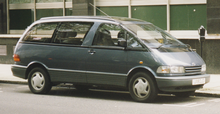 Toyota Previa (UK)
Toyota Previa (UK) Toyota Previa (Europe)
Toyota Previa (Europe)
The first UK market Previas were sold in September 1990, with one trim level called GL, followed by GX and GS in later years. No diesel engine Previas were made for the UK market.
Netherlands
The first generation Previa was marketed in the Netherlands between 1991 and 1994. In 1994, the supercharged or SC model was made standard on all Previas. The only engine available was a 2.4-liter 4-cylinder engine until 1995. Trim levels were base (later renamed to i denoting an injection engine), GL, GLi and GXi. The 2.2-liter diesel version was a popular grey import.
Australia
In Australia, the Tarago was offered in GL/GLi, GLS and GLX forms with 7–8 passenger seating from launch in September 1990. In addition to the Australian market, there were various special edition models available, which varied in trim levels. These include the RV (either 5-speed manual or 4-speed automatic with 4WD), commemorative Rugby World Cup editions and Getaway. Feature-wise, all of the special edition models are marketed between the base GLi and GLX models. When the later-style update models were released in Australia, the top-of-the-line GLS model was renamed "Ultima" and the Getaway became a mainstay trim level, being renamed Getaway II.
Additional notes
This section has multiple issues. Please help improve it or discuss these issues on the talk page. (Learn how and when to remove these messages)
|
- North American Previas with the five-speed manual were made from 1990 through to 1993 (model year 1991 to 1993); none of these are equipped with the supercharged engine.
- Starting in 1991 for model year 1992, North American Previas came with a driver's side airbag and third brake-light. Dual airbags became standard in September 1993 for model year 1994, making it the first minivan to offer a passenger airbag as standard.
- From 1991 to 1997 (from 1992 to 1997 model years), North American Previas came with a swivel feature on the optional middle-row captain's chairs; 1990 to 1991 production (1991 model year) had fixed optional captain's chairs.
- Available on Previas outside the U.S., was an ice-maker/refrigerator that doubled as a beverage heater called the Hot/Cool Box.
- The supercharged engine is different from the normally aspirated engine, owing to a slight decrease in compression ratio and stronger engine internals. The supercharger is engaged on-demand by an electromagnetic clutch, based on input from the engine management system computer (ECU).
- Previas have optional dual moonroofs: A power horizontal-sliding glass moonroof above the middle row of passengers, and a pop-up glass moonroof above the front seats.
- Previas were also the first van to pass all US safety standards as pertaining to front impact, driver airbag, passenger airbag, center-mounted brake light, ABS, daylights, etc.
- Fuel efficiency is below average (11–13 L/100 km or 18.1–21.4 mpg city, 10–11 L/100 km or 21.4–23.5 mpg highway); the small four-cylinder engine needs to work a bit harder owing to the power to weight ratio of the vehicle, compared to contemporary 6-cylinder engines. The supercharged engine has improved power and gives better fuel consumption.
- The Previa gives a practically panoramic view, excluding the pillars behind the front doors. This has the side effect of effectively turning the van into a greenhouse, causing it to accumulate heat in a short period of time. Solar control glass later became an option to help alleviate the problem.
- Previas are affectionately called "eggvans", "eggs" or "beans", because of their shape. In Australia, they have been referred to as "Wombats", because they somewhat resemble the marsupial of the same name. In New Zealand, they are very popular with freedom campers and are referred to as "Bucky" buses.
- In the United States, the first generation Previa model variations, in order of lowest to highest price/option features, are: DX, DX All-Trac, DX S/C, LE, LE All-Trac, LE S/C, LE S/C All-Trac (where S/C refers to the supercharged engine, and All-Trac refers to all-wheel drive).
- The front passenger seat and a section of floor pan must be removed to perform engine maintenance because there is not enough room to access spark plug leads or spark plugs.
- When the Insurance Institute for Highway Safety tested the 1996 model in the offset frontal crash test, it revealed many safety problems: the cabin structure was unstable, the steering wheel moved upward all the way to the windshield, the lap belt tore which allowed the dummy to end up in a partially reclining position, and there were high forces on both of the lower legs, in which the IIHS evaluated it "Poor".
- In some countries (mainly Australia, Japan and the United Kingdom), unsold Estimas and Lucidas were re-badged as 1995/1996 Previas.
Second generation (XR30/XR40; 2000)
Motor vehicle| Second generation (XR30, XR40) | |
|---|---|
 Pre-facelift Previa (Europe) Pre-facelift Previa (Europe) | |
| Overview | |
| Also called |
|
| Production | January 2000 – December 2005 |
| Assembly | Japan: Kariya, Aichi (Fujimatsu plant); Toyota, Aichi (Motomachi plant) |
| Designer | Hiroshi Okamoto (1997) |
| Body and chassis | |
| Layout | |
| Platform | Toyota K platform |
| Related | |
| Powertrain | |
| Engine | |
| Electric motor | Synchronous motor (hybrid)
|
| Transmission |
|
| Battery | 1.4 kWh nickel–metal hydride |
| Dimensions | |
| Wheelbase | 2,900 mm (114.2 in) |
| Length | 4,750 mm (187.0 in) |
| Width | 1,790 mm (70.5 in) |
| Height | 1,770 mm (69.7 in) |
| Curb weight | 1,640–1,850 kg (3,616–4,079 lb) |
The first generation Previa was sold outside the United States until 8 January 2000, when a newer front-wheel drive second generation replaced it. The second generation was not available in North America, as they received the Toyota Sienna. The second generation Previa had a slightly longer wheelbase (2900 mm) and was both narrower (1790 mm) and lower (1770 mm) than the first one; it switched to FF layout and was based on the Camry platform.
It was produced with sliding rear passenger doors on both sides and offered space for up to six, seven or eight passengers and, as with the first generation, was sold as the Estima in Japan and as the Tarago in Australia. The range available in Australia was the GLi, GLX and Ultima.
Models sold on the European markets were available with both gasoline and diesel-powered four-cylinder engines. The diesel engine was a 2.0-liter 1CD-FTV with 85 kW (116 PS) and the gasoline-powered one a 2.4-liter 2AZ-FE with 115 kW (156 PS). Both models featured a five-speed manual transmission as the part of standard equipment, while a four-speed automatic was available as an option on gasoline-powered model.
Australian models (known locally as ACR30R) were only available with the 2.4-liter petrol engine and a four-speed automatic.
In the UK, GS, GLS and CDX trim levels were available. When the facelift was introduced in June 2003, these became T2, T3 and T Spirit respectively.
In Japan, a 3.0-liter V6 engine and a 2.4-liter hybrid version of the Estima were available.
-
Pre-facelift Previa (Europe)
-
 Pre-facelift Estima L (Japan)
Pre-facelift Estima L (Japan)
-
 Pre-facelift Estima L (Japan)
Pre-facelift Estima L (Japan)
-
 Facelift Previa (Europe)
Facelift Previa (Europe)
-
 Facelift Previa (Europe)
Facelift Previa (Europe)
-
Interior
Estima Hybrid
The Estima Hybrid employed the Toyota Hybrid Synergy Drive and used two electric motors. A 2.4-liter gasoline engine and a 13 kW (17 hp) electric motor power the front wheels, while the rear wheels are propelled by a 18 kW (24 hp) electric motor. The vehicle had been on sale in Japan since June 2001. Production of the hybrid started in May 2001 at the Motomachi plant and June 2002 at the Fujimatsu plant. It is claimed by Toyota to be the world's first hybrid minivan.
Third generation (XR50; 2006)
Motor vehicle| Third generation (XR50) | |
|---|---|
 Pre-facelift Toyota Previa (China) Pre-facelift Toyota Previa (China) | |
| Overview | |
| Also called |
|
| Production | January 2006 – October 2019 |
| Assembly | Japan: Kariya, Aichi (Fujimatsu plant); Toyota, Aichi (Motomachi plant) |
| Designer | Kuniaki Toyooka |
| Body and chassis | |
| Layout | |
| Platform | Toyota New MC platform |
| Related | Toyota Alphard (AH20) |
| Powertrain | |
| Engine | |
| Transmission |
|
| Dimensions | |
| Wheelbase | 2,950 mm (116.1 in) |
| Length |
|
| Width |
|
| Height | 1,750 mm (68.9 in) |
| Curb weight | 1,725–1,915 kg (3,803–4,222 lb) |
The third-generation model was introduced in 2006 in Japanese and Australian markets as the Estima and Tarago respectively, and as the Previa in other markets. This generation was notably absent from the European market.
Features include an available second generation Hybrid Synergy Drive drivetrain (only in the Japanese market), automatic parallel and reverse parking (only on Toyota Estima), Lane-Keep Assist (LKA) system which detects the lane markers on the road and steers the car on the right direction (for Estima only), Adaptive Front-Lighting System low beam headlamps which assists to light up the upcoming road around a bend, track-mounted second row reclining seats with footrests, and power-folding split third row seats (for seven-seater models). It received a minor facelift in 2009. G-BOOK was added to the list of optional features. Active driver assist features such as Lane Keeping Assist and Dynamic Radar Cruise Control were offered as an option exclusively to V6 variants.
In some markets such as Hong Kong and Taiwan, Toyota announced the 3.5-liter V6 model in January 2007, but was dropped from the lineup after its major facelift in 2016.
In the Philippines, the XR50 replaced the XR40 Previa in 2009. It only comes in the 2.4L Q variant. It is powered by Toyota's 2.4L 2AZ-FE inline-four engine with VVT-i paired to a 4-speed automatic transmission. It came with power sliding doors, automatic climate control, faux wood trim, 2DIN 6 CD audio system, speakers, remote keyless entry, and leather seats among other features.
-
 2006 Toyota Estima Aeras (Japan)
2006 Toyota Estima Aeras (Japan)
-
 2008 Toyota Estima Aeras (Japan)
2008 Toyota Estima Aeras (Japan)
-
 2014 Toyota Estima Hybrid Aeras
2014 Toyota Estima Hybrid Aeras
-
 2013 Toyota Estima Hybrid Aeras
2013 Toyota Estima Hybrid Aeras
-
 Facelift Toyota Previa (China)
Facelift Toyota Previa (China)
-
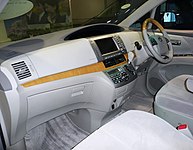 Interior (pre-facelift)
Interior (pre-facelift)
Estima Hybrid
The third generation Estima Hybrid is powered by Toyota's 2.4-liter E-Four hybrid system with all-wheel drive. The hybridized Estima bears the model code AHR20 and is specifically marketed and sold exclusively in China and Japan, with limited importation to Australia. It is said to be similar to that of the Lexus RX 400h, but a generation behind.
Tarago
The Tarago was released in March 2006 bearing the ACR50R model code featuring the 2.4-liter 2AZ-FE inline-four engine found in the ACV40R Camry. In February 2007, Toyota released the GSR50R model with the 3.5-liter 2GR-FE V6 engine producing 202 kW (271 hp) and 340 N⋅m (250 ft⋅lbf) found in the GSV40R Aurion.
The model received a facelift in 2009, with revisions to the headlamps and bumpers. The option of a seven-seater variant was introduced in 2008. Another update was released in 2012 with smart start as standard on all models, smart entry on GLX V6 and Ultima models, new audio systems on all models, automatic headlights and a new Rustic Brown colour option. It also received the major facelift in 2016, with updated interior and other new standard features offered, however it still bears its exterior looks mostly unchanged as with the pre-facelift design. It is available as a family van, a taxicab for regular passengers and a specially designed wheelchair accessible taxi featuring a ramp and longer wheelbase.
In May 2019, Toyota revealed the Granvia, which is heavily based on the latest HiAce van. Toyota Australia confirmed the Granvia will replace the Tarago by the end of 2019, however, they were sold alongside each other for a short period of time. As of March 2020, the Tarago has been discontinued in the Australian market and removed from the Toyota Australia website.
Facelift (2016)
The facelifted model was launched in mid-2016, its dimensions remain mostly unchanged while it receives various new additional equipment to keep up with its competitors. In the interior features a redesigned multifunction steering wheel and a piano black center console that neatly houses a large touchscreen infotainment display. A new safety system "Toyota Safety Sense C" was offered for the first time in the facelifted Estima, but only for Japanese models. The former includes pre-collision system with pedestrian detection function, lane keep assist, high beam assist and radar cruise control.
Along with the new safety features comes with slightly redesigned headlights with LED daytime running lights, tail lights, bumpers, as well as interior with updated steering wheel design, it also becomes the first Toyota to have 360 degree 99% UV cut glass preventing 99% of UV rays from entering into the vehicle creating a cooler environment overall, this 99% UV cut glass also gets a recommendation from Skin Cancer Foundation and has a SPF 50+/PA++++ rating. The Estima drops its 3.5 L V6 engine option and now only offers the 2.4 L inline-4 producing 170 PS (130 kW), and 224 N⋅m (165 ft⋅lbf) and its hybrid variant.
-
 Toyota Estima Hybrid Aeras (2016 facelift)
Toyota Estima Hybrid Aeras (2016 facelift)
-
 Toyota Estima Hybrid Aeras (2016 facelift)
Toyota Estima Hybrid Aeras (2016 facelift)
-
 Interior (2016 facelift)
Interior (2016 facelift)
References
- ^ Takeyama, Eitaro (6 September 2019). "トヨタ、エスティマ生産終了へ 「天才タマゴ」" [Toyota Estima to end production]. Asahi Shimbun Digital (in Japanese). Japan. Retrieved 22 September 2019.
- "トヨタ ラインナップ | 現在販売していないクルマ | エスティマ" [Toyota lineup | Cars not currently on sale | Estima] (in Japanese). Japan: Toyota. Retrieved 20 December 2020.
- ^ "Affiliates (Toyota wholly-owned subsidiaries)-Toyota Auto Body Co., Ltd". Toyota Motor Corporation. 2012. Retrieved 3 December 2015.
- Toyota Jidosha Kabushiki Kaisha. "US Patent D305624". Archived from the original on 4 November 2013. Retrieved 3 November 2013.
- "1990–2000 Toyota Estima". Right Drive. Canada. Archived from the original on 19 June 2012. Retrieved 3 November 2013.
- ^ "IIHS-HLDI: Toyota Previa". Iihs.org. 2 September 2005. Retrieved 30 October 2010.
- "Toyota Previa (1990–2000) used car review". UK: RAC. 29 October 2004. Retrieved 30 November 2019.
- "Review: Toyota Previa (1990–2000)". UK: Honest John. Retrieved 30 November 2019.
- Matras, John (April 1994). "Supercharging to the rescue". Popular Science.
- ^ "Motomachi Plant". Toyota Motor Corporation. 2012. Retrieved 3 July 2014.
- "岡本浩志" [Okamoto Hiroshi] (in Japanese). Chiba University. 2006. Retrieved 21 June 2016.
- Olausson, Kenneth, ed. (September 2001), Bilkatalogen 2002 (Swedish edition of German Auto Katalog) (in Swedish), Solna, Sweden: Bilinfo Print AB, pp. 286–287
- "Passenger car price list January 2003", UK: Toyota (GB), January 2003
- "Previa" (brochure), UK: Toyota (GB), July 2003
- Thorp, Chris (19 August 2003). "Toyota Estima Hybrid". Auto Express. Retrieved 2 November 2015.
- Nunez, Alex (13 June 2006). "Toyota Estima Hybrid gets a full redesign". Autoblog Green. Retrieved 20 November 2009.
- "Japanese Production Sites" (Press release). Japan: Toyota. 6 March 2015. Archived from the original on 18 March 2015.
- "Facelifted Estima Specs (2016)". Goo-net-Exchange.
- Tan, Paul. "Toyota Estima receives a facelift in Japan". Paultan.org. Retrieved 30 October 2010.
- Hermosa, Tito F. (17 August 2011). "2011 Toyota Previa 2.4Q review". autoindustriya.
- Banzon, Sharleen (September 2009). "2009 Toyota Previa Review". Top Gear Philippines.
- "Toyota Estima AHR20 cars for sale or order in Australia". Carsales. Retrieved 20 December 2023.
- Cobb, Jeff (10 September 2013). "Toyota's Fuel-Sipping Estima And Alphard Hybrid Minivans – Off Limits For US". Hybridcars.com. Retrieved 2 November 2015.
- "ACR50R Tarago". GoAuto. 1 March 2006. Retrieved 20 December 2023.
- "Toyota Tarago GLi GSR50R cars for sale or order in Australia". Carsales. Retrieved 20 December 2023.
- "Toyota Unveils All-New Luxury Granvia | Latest News". New Cars Toyota Australia: Prices, Service Centres, Dealers, Test Drives. Retrieved 21 May 2019.
- "2016 Toyota Estima facelift". Paultan.org. Retrieved 30 June 2016.
External links
| Toyota road minivan/van timeline, international markets, 1985–present | |||||||||||||||||||||||||||||||||||||||||||||||||||||||||||||||||||||||||||||||||||||||||||||||||||||||||||||||||||||||||||||||||||||||||||||||||||||||||||||||||||||||||||||||||||||||||||||||||||||||||||||||||||||||||||||||||||||||||||||||||||||||||||||||||||||||||||||||||||||||||||||||||||||||||||||||||||||||||||||||||||||||||||||||||||||||||||||||||||||||||||||||||||||||||||||||||||||||||||||||||||||||||||||||||||||||||||||||||||||||||||||||||||||||||||||||||||||||||||||||||||||||||||||||||||||||||||||||||||||||||||||||||||||||||||||||||||||||||||||||||||||||||||||||||||||||||||||||||||||||||||||||||||||||||||||||||||||||||||||||||||||||||||||||||||||||||||||||||||||||||||||||||||||||||||||||||||||||||||||||||||||||||||||||||||||||||||||||||||||||||||||||||||||||||||||||||||||||||||||||||||||||||||||||||||||||||||||||||||||||||||||||||||||||||||||||||||||||||||||||||||||||||||||||||||||||||||||||||||||||||||||||||||||||||||||||||||||||||||||||||||||||||||||||||||||||||||||||||||||||
|---|---|---|---|---|---|---|---|---|---|---|---|---|---|---|---|---|---|---|---|---|---|---|---|---|---|---|---|---|---|---|---|---|---|---|---|---|---|---|---|---|---|---|---|---|---|---|---|---|---|---|---|---|---|---|---|---|---|---|---|---|---|---|---|---|---|---|---|---|---|---|---|---|---|---|---|---|---|---|---|---|---|---|---|---|---|---|---|---|---|---|---|---|---|---|---|---|---|---|---|---|---|---|---|---|---|---|---|---|---|---|---|---|---|---|---|---|---|---|---|---|---|---|---|---|---|---|---|---|---|---|---|---|---|---|---|---|---|---|---|---|---|---|---|---|---|---|---|---|---|---|---|---|---|---|---|---|---|---|---|---|---|---|---|---|---|---|---|---|---|---|---|---|---|---|---|---|---|---|---|---|---|---|---|---|---|---|---|---|---|---|---|---|---|---|---|---|---|---|---|---|---|---|---|---|---|---|---|---|---|---|---|---|---|---|---|---|---|---|---|---|---|---|---|---|---|---|---|---|---|---|---|---|---|---|---|---|---|---|---|---|---|---|---|---|---|---|---|---|---|---|---|---|---|---|---|---|---|---|---|---|---|---|---|---|---|---|---|---|---|---|---|---|---|---|---|---|---|---|---|---|---|---|---|---|---|---|---|---|---|---|---|---|---|---|---|---|---|---|---|---|---|---|---|---|---|---|---|---|---|---|---|---|---|---|---|---|---|---|---|---|---|---|---|---|---|---|---|---|---|---|---|---|---|---|---|---|---|---|---|---|---|---|---|---|---|---|---|---|---|---|---|---|---|---|---|---|---|---|---|---|---|---|---|---|---|---|---|---|---|---|---|---|---|---|---|---|---|---|---|---|---|---|---|---|---|---|---|---|---|---|---|---|---|---|---|---|---|---|---|---|---|---|---|---|---|---|---|---|---|---|---|---|---|---|---|---|---|---|---|---|---|---|---|---|---|---|---|---|---|---|---|---|---|---|---|---|---|---|---|---|---|---|---|---|---|---|---|---|---|---|---|---|---|---|---|---|---|---|---|---|---|---|---|---|---|---|---|---|---|---|---|---|---|---|---|---|---|---|---|---|---|---|---|---|---|---|---|---|---|---|---|---|---|---|---|---|---|---|---|---|---|---|---|---|---|---|---|---|---|---|---|---|---|---|---|---|---|---|---|---|---|---|---|---|---|---|---|---|---|---|---|---|---|---|---|---|---|---|---|---|---|---|---|---|---|---|---|---|---|---|---|---|---|---|---|---|---|---|---|---|---|---|---|---|---|---|---|---|---|---|---|---|---|---|---|---|---|---|---|---|---|---|---|---|---|---|---|---|---|---|---|---|---|---|---|---|---|---|---|---|---|---|---|---|---|---|---|---|---|---|---|---|---|---|---|---|---|---|---|---|---|---|---|---|---|---|---|---|---|---|---|---|---|---|---|---|---|---|---|---|---|---|---|---|---|---|---|---|---|---|---|---|---|---|---|---|---|---|---|---|---|---|---|---|---|---|---|---|---|---|---|---|---|---|---|---|---|---|---|---|---|---|---|---|---|---|---|---|---|---|---|---|---|---|---|---|---|---|---|---|---|---|---|---|---|---|---|---|---|---|---|---|---|---|---|---|---|---|---|---|---|---|---|---|---|---|---|---|---|---|---|---|---|---|---|---|---|---|---|---|---|---|---|---|---|---|---|---|---|---|---|---|---|---|---|---|---|---|---|---|---|---|---|---|---|---|---|---|---|---|---|---|---|---|---|---|---|---|---|---|---|---|---|---|---|---|---|---|---|---|---|---|---|---|---|---|---|---|---|---|---|---|---|---|---|---|---|---|---|---|---|---|---|---|---|---|---|---|---|---|---|---|---|---|---|---|---|---|---|---|---|---|---|---|---|---|---|---|---|---|---|---|---|---|---|---|---|---|---|---|---|---|---|---|---|---|---|---|---|---|---|---|---|---|---|---|---|---|---|---|---|---|---|---|---|---|---|---|---|---|---|---|---|---|---|---|---|---|---|---|---|---|---|---|---|---|---|---|---|---|---|---|---|---|---|---|---|---|---|---|---|---|---|---|---|---|---|---|---|---|---|---|---|---|---|---|---|---|---|---|---|---|---|---|---|---|---|---|---|---|---|---|---|---|---|---|---|---|---|---|---|---|---|---|---|---|---|---|---|---|---|---|---|---|---|---|---|---|---|---|---|---|---|---|---|---|---|---|---|---|---|---|---|---|---|---|---|---|---|---|---|---|---|---|---|---|---|---|---|
| |||||||||||||||||||||||||||||||||||||||||||||||||||||||||||||||||||||||||||||||||||||||||||||||||||||||||||||||||||||||||||||||||||||||||||||||||||||||||||||||||||||||||||||||||||||||||||||||||||||||||||||||||||||||||||||||||||||||||||||||||||||||||||||||||||||||||||||||||||||||||||||||||||||||||||||||||||||||||||||||||||||||||||||||||||||||||||||||||||||||||||||||||||||||||||||||||||||||||||||||||||||||||||||||||||||||||||||||||||||||||||||||||||||||||||||||||||||||||||||||||||||||||||||||||||||||||||||||||||||||||||||||||||||||||||||||||||||||||||||||||||||||||||||||||||||||||||||||||||||||||||||||||||||||||||||||||||||||||||||||||||||||||||||||||||||||||||||||||||||||||||||||||||||||||||||||||||||||||||||||||||||||||||||||||||||||||||||||||||||||||||||||||||||||||||||||||||||||||||||||||||||||||||||||||||||||||||||||||||||||||||||||||||||||||||||||||||||||||||||||||||||||||||||||||||||||||||||||||||||||||||||||||||||||||||||||||||||||||||||||||||||||||||||||||||||||||||||||||||||||
| |||||||||||||||||||||||||||||||||||||||||||||||||||||||||||||||||||||||||||||||||||||||||||||||||||||||||||||||||||||||||||||||||||||||||||||||||||||||||||||||||||||||||||||||||||||||||||||||||||||||||||||||||||||||||||||||||||||||||||||||||||||||||||||||||||||||||||||||||||||||||||||||||||||||||||||||||||||||||||||||||||||||||||||||||||||||||||||||||||||||||||||||||||||||||||||||||||||||||||||||||||||||||||||||||||||||||||||||||||||||||||||||||||||||||||||||||||||||||||||||||||||||||||||||||||||||||||||||||||||||||||||||||||||||||||||||||||||||||||||||||||||||||||||||||||||||||||||||||||||||||||||||||||||||||||||||||||||||||||||||||||||||||||||||||||||||||||||||||||||||||||||||||||||||||||||||||||||||||||||||||||||||||||||||||||||||||||||||||||||||||||||||||||||||||||||||||||||||||||||||||||||||||||||||||||||||||||||||||||||||||||||||||||||||||||||||||||||||||||||||||||||||||||||||||||||||||||||||||||||||||||||||||||||||||||||||||||||||||||||||||||||||||||||||||||||||||||||||||||||||
| Toyota light truck timeline, North American market, 1980s–present (model years) | ||||||||||||||||||||||||||||||||||||||||||||||||||||||||||||||||||||||||||||||||||||||||||||||||||||||||||||||||||||||||||||||||||||||||||||||||||||||||||||||||||||||||||||||||||||||||||||||||||||||||||||||||||||||||||||||||||||||||||||||||||||||||||||||||||||||||||||||||||||||||||||||||||||||||||||||||||||||||||||||||||||||||||||||||||||||||||||||||||||||||||||||||||||||||||||||||||||||||||||||||||||||||||||||||||||||||||||||||||||||||||||||||||||||||||||||||||||||||||||||||||||||||||||||||||||||||||||||||||||||||||||||||||||||||||||||||||||||||||||||||||||||||||||||||||||||||||||||||||||||||||||||||||||||||||||||||||||||||||||||||||||||||||||||||||||||||||||||||||||||||||||||||||||||||||||||||||||||||||||||||||||||||||||||||||||||||||||||||||||||||||||||||||||||||||||||||||||||||
|---|---|---|---|---|---|---|---|---|---|---|---|---|---|---|---|---|---|---|---|---|---|---|---|---|---|---|---|---|---|---|---|---|---|---|---|---|---|---|---|---|---|---|---|---|---|---|---|---|---|---|---|---|---|---|---|---|---|---|---|---|---|---|---|---|---|---|---|---|---|---|---|---|---|---|---|---|---|---|---|---|---|---|---|---|---|---|---|---|---|---|---|---|---|---|---|---|---|---|---|---|---|---|---|---|---|---|---|---|---|---|---|---|---|---|---|---|---|---|---|---|---|---|---|---|---|---|---|---|---|---|---|---|---|---|---|---|---|---|---|---|---|---|---|---|---|---|---|---|---|---|---|---|---|---|---|---|---|---|---|---|---|---|---|---|---|---|---|---|---|---|---|---|---|---|---|---|---|---|---|---|---|---|---|---|---|---|---|---|---|---|---|---|---|---|---|---|---|---|---|---|---|---|---|---|---|---|---|---|---|---|---|---|---|---|---|---|---|---|---|---|---|---|---|---|---|---|---|---|---|---|---|---|---|---|---|---|---|---|---|---|---|---|---|---|---|---|---|---|---|---|---|---|---|---|---|---|---|---|---|---|---|---|---|---|---|---|---|---|---|---|---|---|---|---|---|---|---|---|---|---|---|---|---|---|---|---|---|---|---|---|---|---|---|---|---|---|---|---|---|---|---|---|---|---|---|---|---|---|---|---|---|---|---|---|---|---|---|---|---|---|---|---|---|---|---|---|---|---|---|---|---|---|---|---|---|---|---|---|---|---|---|---|---|---|---|---|---|---|---|---|---|---|---|---|---|---|---|---|---|---|---|---|---|---|---|---|---|---|---|---|---|---|---|---|---|---|---|---|---|---|---|---|---|---|---|---|---|---|---|---|---|---|---|---|---|---|---|---|---|---|---|---|---|---|---|---|---|---|---|---|---|---|---|---|---|---|---|---|---|---|---|---|---|---|---|---|---|---|---|---|---|---|---|---|---|---|---|---|---|---|---|---|---|---|---|---|---|---|---|---|---|---|---|---|---|---|---|---|---|---|---|---|---|---|---|---|---|---|---|---|---|---|---|---|---|---|---|---|---|---|---|---|---|---|---|---|---|---|---|---|---|---|---|---|---|---|---|---|---|---|---|---|---|---|---|---|---|---|---|---|---|---|---|---|---|---|---|---|---|---|---|---|---|---|---|---|---|---|---|---|---|---|---|---|---|---|---|---|---|---|---|---|---|---|---|---|---|---|---|---|---|---|---|---|---|---|---|---|---|---|---|---|---|---|---|---|---|---|---|---|---|---|---|---|---|---|---|---|---|---|---|---|---|---|---|---|---|---|---|---|---|---|---|---|---|---|---|---|---|---|---|---|---|---|---|---|---|---|---|---|---|---|---|---|---|---|---|---|---|---|---|---|---|---|---|---|---|---|---|---|---|---|---|---|---|---|---|---|---|---|---|---|---|---|---|---|---|---|---|---|---|---|---|---|---|---|---|---|---|---|---|---|---|---|---|---|---|---|---|---|---|---|---|---|---|---|---|---|---|---|---|---|---|---|---|---|---|---|---|---|---|---|---|---|---|---|---|---|---|---|---|---|---|---|---|---|---|---|---|---|---|---|---|---|---|---|---|---|---|---|---|---|---|---|---|---|---|---|---|---|---|---|---|---|---|---|---|---|---|---|---|---|---|---|---|---|---|---|---|---|---|---|---|---|---|---|---|---|---|---|---|---|---|---|---|---|---|---|---|---|---|---|---|---|---|---|---|---|---|---|---|---|---|---|---|---|---|---|---|---|---|---|
| ||||||||||||||||||||||||||||||||||||||||||||||||||||||||||||||||||||||||||||||||||||||||||||||||||||||||||||||||||||||||||||||||||||||||||||||||||||||||||||||||||||||||||||||||||||||||||||||||||||||||||||||||||||||||||||||||||||||||||||||||||||||||||||||||||||||||||||||||||||||||||||||||||||||||||||||||||||||||||||||||||||||||||||||||||||||||||||||||||||||||||||||||||||||||||||||||||||||||||||||||||||||||||||||||||||||||||||||||||||||||||||||||||||||||||||||||||||||||||||||||||||||||||||||||||||||||||||||||||||||||||||||||||||||||||||||||||||||||||||||||||||||||||||||||||||||||||||||||||||||||||||||||||||||||||||||||||||||||||||||||||||||||||||||||||||||||||||||||||||||||||||||||||||||||||||||||||||||||||||||||||||||||||||||||||||||||||||||||||||||||||||||||||||||||||||||||||||||||





